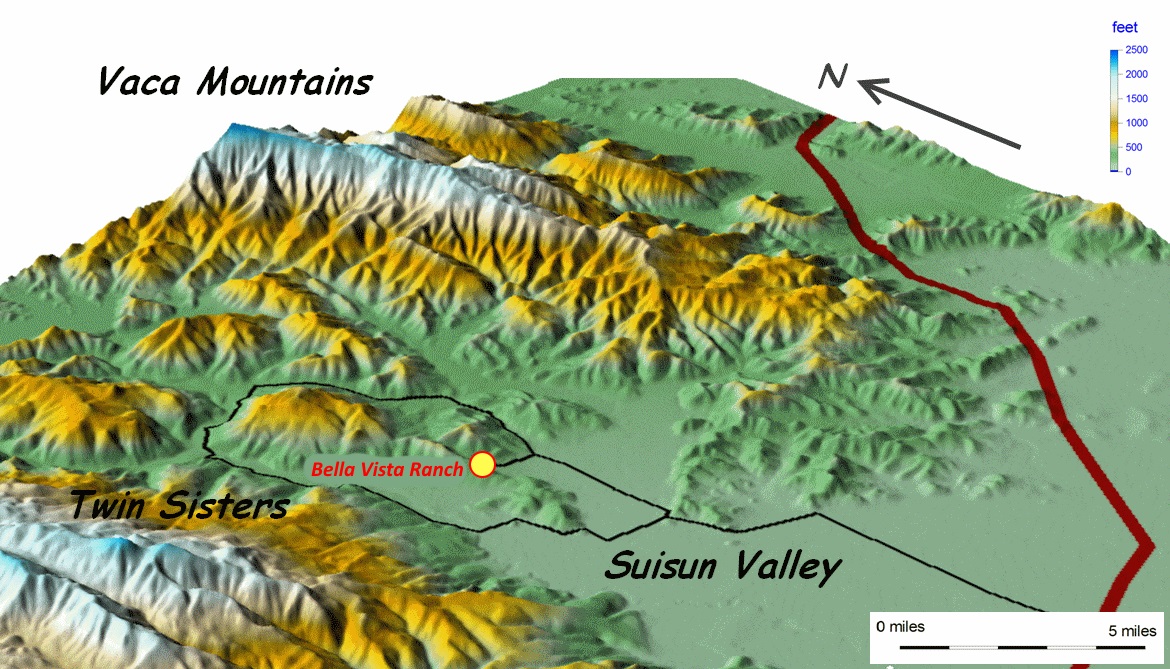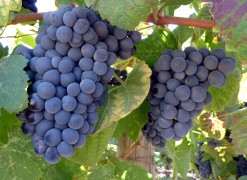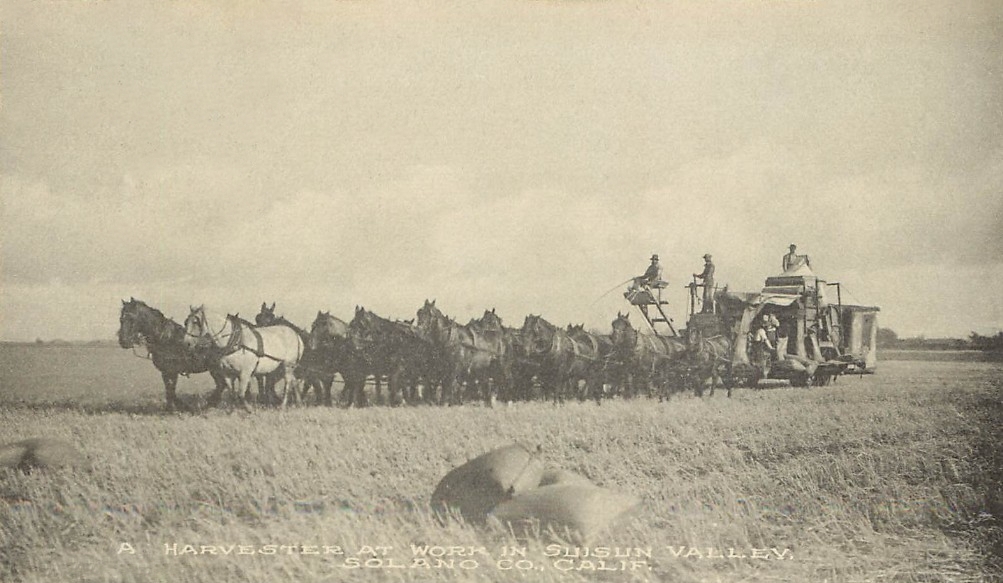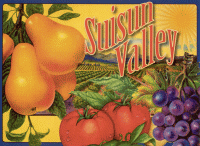Geology and Climate of the Suisun Valley

The Suisun Valley, where Bella Vista Ranch is located, is a region in the California Coast Ranges that is bordered on the east side by the Blue Ridge of the Vaca Mountains, and on the west side by the Howell Mountains (also known as the St. George Range). The valley sits almost entirely within Solano County with a northern terminus near the border with Napa County, and a southern terminus at Suisun Bay in the estuary where the Sacramento River enters San Francisco Bay. The valley is approximately 3 miles wide by 8 miles long, and contains about 15,000 acres of land, much of which is devoted to agriculture. Elevations range from 100 to 200 ft above sea level on the valley floor, rising steeply to 1,122 ft at Okell Hill on the north side, and 2,162 ft on the west side at Twin Sisters, a twin summit that is both a prominent landmark and the high point of the Howell Mountains. It is also the highest privately owned summit in the San Francisco Bay area. Blue Ridge on the east side of the valley exceeds 2,000 ft in elevation for much of its length, and sometimes gets a dusting of snow in the winter. Sedimentary rock composed of sandstone and shale of the Great Valley Sequence, which is Early Cretaceous in age, makes most up the bedrock that is buried beneath the fill of the valley floor. Similar sedimentary rocks crop out in the hills bordering the east and north sides of the valley. By contrast, rocks of the Pliocene-age Sonoma Volcanics, which are mainly pyroclastic breccias and tuffs, with some interbedded volcanic flows, make up the Howell mountains that border the west side of the valley. Suisun and Green Valley Creeks drain the northern uplands and create an alluvial fan that covers most of the valley floor, and builds out to the south into the Suisun Marsh. Soils developed on the Suisun-Green Valley alluvial fan, where most of the farming takes place, range from a very thick layer of Sycamore silty loam that covers most of the valley floor, to thinner Rincon and Brentwood clay loams that develop where the fan laps onto the valley margins, and drainage is somewhat better. Dibble and Los Osos soils that cover sedimentary bedrock in the eastern and northern foothills, and Hambright and Toomes soils that cover volcanic bedrock on the west side generally are more conducive to grazing cattle than growing crops. 
The valley has a semi-coastal Mediterranean climate with a cool wet season from November to April, followed by a warm dry season. Moist winds blow inland from the inlets of San Pablo Bay and Suisun Bay at the headwaters of San Francisco Bay. This winds blow almost continuously from May through October, which minimizes frost danger. Mean rainfall averages about 20 in/yr in the southeast part of the valley to 30 in/yr in the northwest, with nearly all rain falling during the wet season. The climate is classified as mid-region III by the Agricultural Department of the University of California at Davis. The Mediterranean climate of the valley floor is very conducive to growing wine grapes, and more than 3,000 acres are currently planted as vineyard, which represents about 20% of the valley floor. More than twenty varieties of wine grapes are grown here, including Barbera, Cabernet Sauvignon, Chardonnay, French Colombard, Gamay (Valdiguie), Grenache, Merlot, Mouvedre, Muscat Canelli, Petite Sirah, Petite Verdot, Pinot Gris, Pinot Noir, Primitivo, Rousanne, Sauvignon Blanc, Sangiovese, Shiraz, Syrah, Viognier, Riesling, and Zinfandel. However, the valley is believed by some to be particularly well suited to Petite Sirah (Durif) grapes, which can be tricky to grow, but are an acidic, mildow-resistant variety that not only provides a rich purple color and fuller taste to many red wine blends, but make for an elegant varietal wine as well.
Modified from a Wikipedia article originally created by Mike Clark
History of the Suisun Valley

Suisun Valley, where the Bella Vista Ranch is located, is named after the local Native Americans, a distinct tribe known as the Suisun Indians, who spoke a dialect of the Patwin Indian language. Francisco Solano, a Suisun Indian chief, and a protegé of Mexican General Mariano Vallejo, made application in 1837 to the Mexican government for a land grant covering the ancestral Suisun homeland, which basically corresponds to the Suisun Valley flatlands. However, Solano died before this process was complete, and Vallejo quickly stepped in to take over the application. About this same time, the Tolenas and Rio de los Putos grants in the northern and eastern highlands of the valley were awarded to the Armijo and Wolfskill families. These grants represented for the most part the hilly regions bordering the flatlands of the Suisun Indian grant. The California Gold Rush of 1849 followed soon afterward, and brought with it a tremendous influx of settlers to the region, which soon led to land disputes and breaking up of the original land grants into smaller parcels. The early large land holders in the valley generally grazed cattle for a cash crop, but wheat, which is a very drought resistant crop, utlimately became the dominant crop here by the latter part of the 19th century. Huge harvesters, like the one shown in the photo above and right, were a common sight on valley farmlands in the early days, with the wheat being carried by wagon to the port of nearby Suisun City where it shipped out on schooners that sailed out through San Francisco Bay to markets all over the world. However, orchards of dominantly pears and apricots began to replace wheat and other row crops around the turn of the century, so that fruit orchards by the 1920s became the dominant agricultural industry in the valley. 
The first vineyards in Suisun Valley were planted about 1860 by John Votypke and the brothers Henry and Claus Schultz, but vineyards remained a minor crop for at least the next hundred years. This changed when the "wine boom" that began in the 1960s in adjacent Napa Valley spread into Suisun Valley as well, and wine grapes now constitute the main crop of the valley. Today more than 20% of the valley is planted in grapes, with new vineyards appearing every year. Yet fruit orchards are still an important crop, as well as wheat, and various row crops such as soy beans, sorghum, corn, and sunflowers. The growing of olives for olive oil has recently become important as well, and several Suisun Valley vineyards, like Bella Vista Ranch, grow both grapes and olives. The first commercial winery in the valley was started in the 1860s by the Schultz brothers, who after making wine for twenty or so years sold their operation in 1889 to Suisun Valley winemaker Louis Mangels. His Solano Winery by 1906 was making 500,000 gallons of wine a year and was one of the largest wineries in the state. Several family operations continued to make wine into the 1920s, but these disappeared during prohibition. Italian vintners John Cadenasso (Cadenasso Vineyards), and the Brea brothers with Mario Lanza (Wooden Valley Winery) started making wine again on a small scale in 1933 when prohibition ended, and benefitted in the 1960s from the explosive growth of the wine industry in adjacent Napa Valley. The wine industry here continues to grow, with new wineries appearing every year. The Western Solano County Grape Growers Association successfully petitioned the United States Bureau of Alcohol, Tobacco and Firearms in 1982 for formal recognition as an AVA (American Vitacultural Area), and the Suisun Valley Grape Growers Association formed in 2003 to promote the local industry. The latter group, now known as the Suisun Valley Vintners and Growers Association, currently lists several Suisun Valley wineries on their website. Both the Suisun Valley AVA and the Napa Valley AVA are part of the North Coast AVA, a regional appellation that includes the grape-growing districts of six counties located north of San Francisco Bay. Today Suisun Valley is recognized by the U.S. Government as an "official" wine grape growing district with unique qualities of geography, soil and climate that distinguish it from other districts in the state.
Modified from a Wikipedia article originally created by Mike Clark
|
